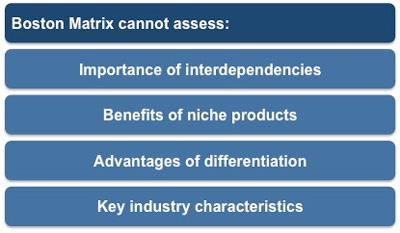Advantages and Disadvantages

Any organization using the Boston Matrix to help define its strategy, rather than just provide an indication of future potential, must properly represent the cash flow of each business unit or product being assessed. There has been a tendency for users to oversimplify the analysis and to focus on categorizing products or business units as Cash Cows, Stars, Question Marks, or Dogs, rather than considering cash flow.
This trivial approach has led to the matrix being seen as impractical for organizations that want to develop their business, resulting in its decline in popularity. In 1992 a study by Slater and Zwirlein actually showed that of the 129 firms they reviewed those who had used the Boston Matrix as part of their portfolio planning presented lower shareholder returns to their investors.
 |
The danger of focussing on market growth and market share is that it can encourage you to disregard other key factors that define your competitive position. In addition, you need to take into account interdependencies between your products and be aware of the merits of differentiation as a way to gain a competitive edge.
The Boston Matrix assumes that the higher your market share the more profitable your product or business unit will be. It also rejects the possibility that a niche product with a low market share can be profitable, whilst in reality many Dogs offer higher profit margins than many Cash Cows.
Another key factor the matrix is unable to take into account is the characteristics of the particular industry sector you operate in. For instance, ranking products or business units often has a subjective aspect and an element of guesswork with regard to future growth. Some industry sectors may be more optimistic, insistent, and persuasive than others about the rates of market growth and their own market share. The senior management of many 'dot.com' companies in the early 2000s demonstrated this clearly.
There are other analysis tools that can help you assess your environment such as PESTLE Analysis and Porter's Five Forces. If you are unfamiliar with these tools or want to understand them in greater detail then download our PESTLE Analysis eBook and our Porter's Five Forces eBook.
You may also be interested in: Introduction to the Boston Matrix, Classifying Products and Business Units, Stars, Question Marks, Cash Cows, Dogs, Using the Boston Matrix at Brand Level, A Balanced Portfolio and Advantages and Disadvantages.



